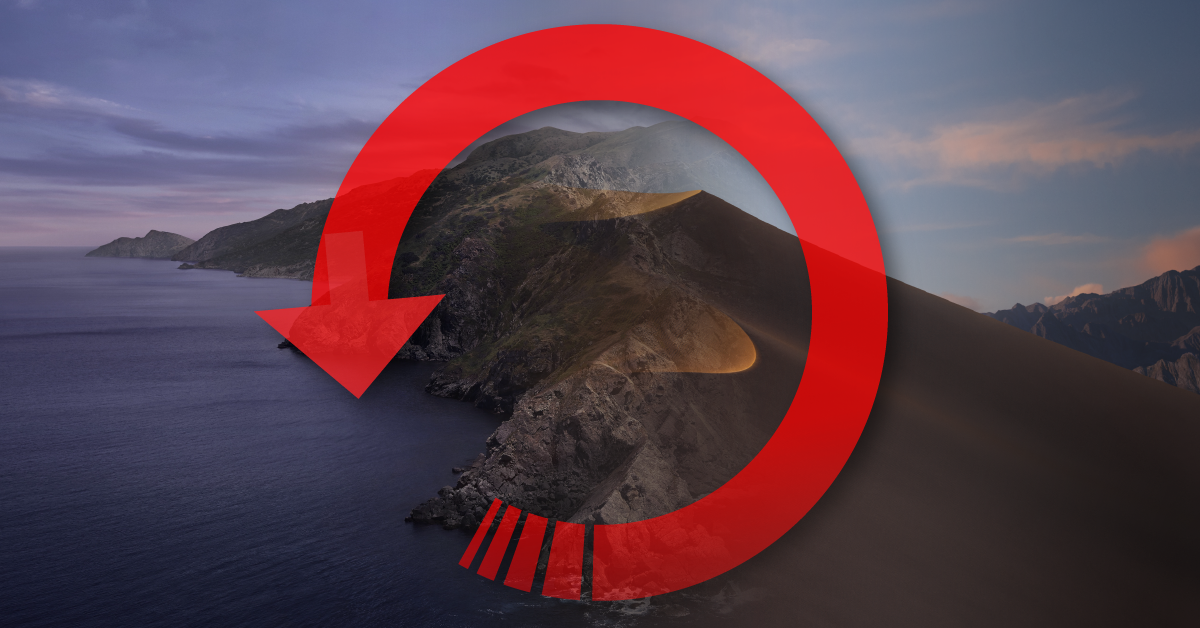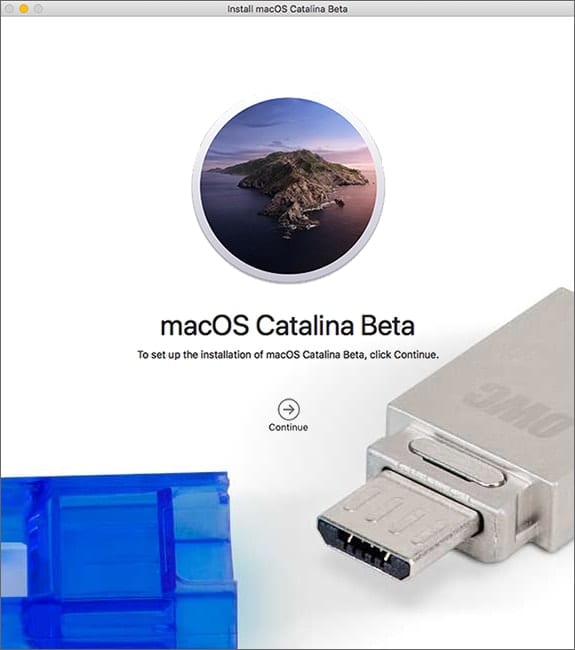These advanced steps are primarily for system administrators and others who are familiar with the command line. You don't need a bootable installer to upgrade macOS or reinstall macOS, but it can be useful when you want to install on multiple computers without downloading the installer each time.
- To create a bootable Mac drive you need any disk with Mac OS X 10.11.0 El Capitan or newer (10.12 Sierra, 10.13 High Sierra, 10.14 Mojave, 10.15 Catalina) either running as your main system, or just being installed on a drive that's connected to your Mac at the moment.
- OS X El Capitan; Create the bootable Catalina USB drive. After everything has been downloaded, there is another few steps that you’ll need to take. First and foremost, make sure that that drive has at least 12GB of available storage. Then, plug the USB flash drive into your Mac.
Step 5: Once the progress bar is at 100%, a bootable macOS USB is ready. After that, you can use that USB drive for installing macOS. This is one of the easiest way to create a bootable macOS USB on a Windows PC. The steps are simple and instructions are pretty clear. Step 3: Create a bootable USB disk. Next we need to turn out USB drive into a bootable USB disk so that we can use it to install a new copy of macOS on our Mac after we have reformatted it (that.
Currently, you can only create a bootable installer for macOS Big Sur, Catalina, Mojave, High Sierra, or El Capitan. If you want to go back to your previous macOS, here's how to downgrade macOS. Aug 13, 2021 What you need to create a bootable installer. A USB flash drive or other secondary volume formatted as Mac OS Extended, with at least 14GB of available storage; A downloaded installer for macOS Big Sur, Catalina, Mojave, High Sierra, or El Capitan; Download macOS. Download: macOS Big Sur, macOS Catalina, macOS Mojave, or macOS High Sierra.
What you need to create a bootable installer
- A USB flash drive or other secondary volume formatted as Mac OS Extended, with at least 14GB of available storage
- A downloaded installer for macOS Big Sur, Catalina, Mojave, High Sierra, or El Capitan
Download macOS
- Download: macOS Big Sur, macOS Catalina, macOS Mojave, or macOS High Sierra
These download to your Applications folder as an app named Install macOS [version name]. If the installer opens after downloading, quit it without continuing installation. To get the correct installer, download from a Mac that is using macOS Sierra 10.12.5 or later, or El Capitan 10.11.6. Enterprise administrators, please download from Apple, not a locally hosted software-update server. - Download: OS X El Capitan
This downloads as a disk image named InstallMacOSX.dmg. On a Mac that is compatible with El Capitan, open the disk image and run the installer within, named InstallMacOSX.pkg. It installs an app named Install OS X El Capitan into your Applications folder. You will create the bootable installer from this app, not from the disk image or .pkg installer.
Use the 'createinstallmedia' command in Terminal
- Connect the USB flash drive or other volume that you're using for the bootable installer.
- Open Terminal, which is in the Utilities folder of your Applications folder.
- Type or paste one of the following commands in Terminal. These assume that the installer is in your Applications folder, and MyVolume is the name of the USB flash drive or other volume you're using. If it has a different name, replace
MyVolumein these commands with the name of your volume.
Big Sur:*
Catalina:*
Mojave:*
High Sierra:*

El Capitan:
Make Bootable El Capitan Usb On Catalina Download
* If your Mac is using macOS Sierra or earlier, include the --applicationpath argument and installer path, similar to the way this is done in the command for El Capitan.
After typing the command:
- Press Return to enter the command.
- When prompted, type your administrator password and press Return again. Terminal doesn't show any characters as you type your password.
- When prompted, type
Yto confirm that you want to erase the volume, then press Return. Terminal shows the progress as the volume is erased. - After the volume is erased, you may see an alert that Terminal would like to access files on a removable volume. Click OK to allow the copy to proceed.
- When Terminal says that it's done, the volume will have the same name as the installer you downloaded, such as Install macOS Big Sur. You can now quit Terminal and eject the volume.
Use the bootable installer
Macos Catalina Usb
Determine whether you're using a Mac with Apple silicon, then follow the appropriate steps:
Apple silicon
- Plug the bootable installer into a Mac that is connected to the internet and compatible with the version of macOS you're installing.
- Turn on your Mac and continue to hold the power button until you see the startup options window, which shows your bootable volumes and a gear icon labled Options.
- Select the volume containing the bootable installer, then click Continue.
- When the macOS installer opens, follow the onscreen instructions.
How To Make A Bootable Macos Catalina Usb Install Drive
Intel processor
- Plug the bootable installer into a Mac that is connected to the internet and compatible with the version of macOS you're installing.
- Press and hold the Option (Alt) ⌥ key immediately after turning on or restarting your Mac.
- Release the Option key when you see a dark screen showing your bootable volumes.
- Select the volume containing the bootable installer. Then click the up arrow or press Return.
If you can't start up from the bootable installer, make sure that the External Boot setting in Startup Security Utility is set to allow booting from external media. - Choose your language, if prompted.
- Select Install macOS (or Install OS X) from the Utilities window, then click Continue and follow the onscreen instructions.
Learn more
For more information about the createinstallmedia command and the arguments that you can use with it, make sure that the macOS installer is in your Applications folder, then enter the appropriate path in Terminal:
- Big Sur: /Applications/Install macOS Big Sur.app/Contents/Resources/createinstallmedia
- Catalina: /Applications/Install macOS Catalina.app/Contents/Resources/createinstallmedia
- Mojave: /Applications/Install macOS Mojave.app/Contents/Resources/createinstallmedia
- High Sierra: /Applications/Install macOS High Sierra.app/Contents/Resources/createinstallmedia
- El Capitan: /Applications/Install OS X El Capitan.app/Contents/Resources/createinstallmedia
A bootable installer doesn't download macOS from the internet, but it does require an internet connection to get firmware and other information specific to the Mac model.
If your Mac suddenly refuses to boot up properly, you might need a bootable macOS USB installer to make repairs. But how do you create such a disk if all you're left with is a Windows 10 computer? Fortunately, there's a great tool that you can use for free to create bootable macOS media on a USB drive in a Windows 10 environment. This article shows you how to download a macOS DMG file, format a USB drive using a GUID Partition Table, burn the DMG to the drive and boot your Mac from the USB. All the steps except the last one are done on a Windows 10 machine.
Part 1: Download macOS or Mac OS X DMG File
The first step is to get the DMG disk image file for the version of macOS that you want. You can get a copy of the latest macOS version from Apple download portal or App Store here. There are also several other direct download sites that offer various versions of Mac OS X in DMG format rather than the standard APP format that runs on Mac. Since you're working in a Windows environment, you need the DMG rather than the APP file.
macOS DMG Download Link:
Create A Bootable Macos Catalina Usb Install Drive Shaft
Part 2: Format USB Drive to GPT (Optional)
Updates (Dec 8, 2020): The latest version of UUByte DMG Editor is able to format the USB automatically, so this part is optional. Follow the steps only when the burning process failed in Part 3.
Mostly, the USB drive was formmated to FAT32 in default when being shipped out from the factory. However, FAT32 can be only used for installing OS with legacy BISO, which doesn't work for macOS. So the next step is to format your USB drive in the GPT partition style in order to burn installation files to the desired USB drive. You can do this in Command Prompt as admin. In elevated Command Prompt (Ctrl+Shift+Enter), input the following series of commands followed by Enter after each line:
Diskpart
List disk
Select Disk X (X stands for the USB drive name that appears after the previous command)
Clean
Convert GPT
Create partition primary
Part 3: Create Bootable macOS USB from Windows 10/8/7 PC
You have now formatted the partition of USB drive. It's time to download UUByte DMG Editor for Windows. Although this is a premium software, you can use the initial free trial period to create a bootable macOS USB on Windows 10. After installing the application, follow the sequence of steps shown below:

Step 1: Right-click the software icon on desktop and select 'Run as Administrator' from the contextual menu. Choose 'Run' when prompted.
How To Create A Bootable Macos Catalina 10.15 Usb Install Drive
Step 2: Insert your formatted USB drive, and click 'Burn' tab on the main screen.
Step 3: Click 'Browse' button to import macOS dmg file into the program. And select the USB drive name from the second row. You can also set a volume labe for that USB drive.
Create A Bootable Macos Catalina Usb Install Drive Windows 7
Step 4: Click 'Burn' button at the bottom to start the process. You will see a progress bar and wait around 10 minutes to get it done.

Step 5: Once the progress bar is at 100%, a bootable macOS USB is ready. After that, you can use that USB drive for installing macOS.
How To Create A Bootable Mac Os Catalina Usb Install Drive
Docker ubuntu centos command. This is one of the easiest way to create a bootable macOS USB on a Windows PC. The steps are simple and instructions are pretty clear.
Part 4: Boot Mac from macOS USB Drive for Installation
How To Make A Bootable Usb For Macos Catalina
Now remove the USB drive and insert it into the Mac computer. To boot from the disk, you need to hold down the option key when you hear the boot chime. This will take you to the Startup Disk Manager, where you should be able to see the USB drive. It might have a different name, but as long as it is bootable, you'll be able to see it there. Once you select it, the computer will boot from the disk and the macOS installation will begin.
Conclusion:
The whole process might look a bit complicated if this is your first time, but just follow the instructions in this article and you should be fine. That being said, you need to be careful when downloading the DMG file and formatting your USB drive. If you don't do these two steps correctly, the output drive from the UUByte DMG Editor software won't be bootable, which means you can't install macOS from that USB drive, and you may need to do the whole thing over again.